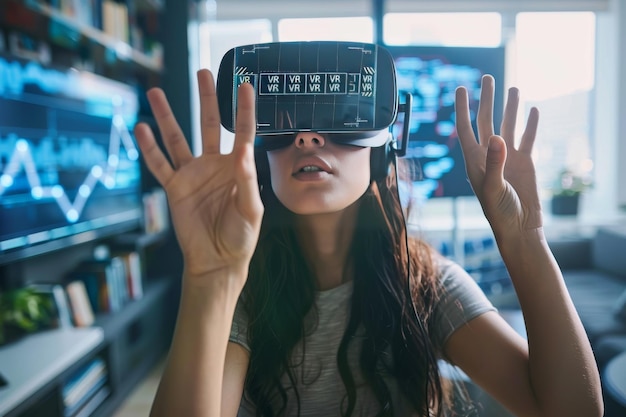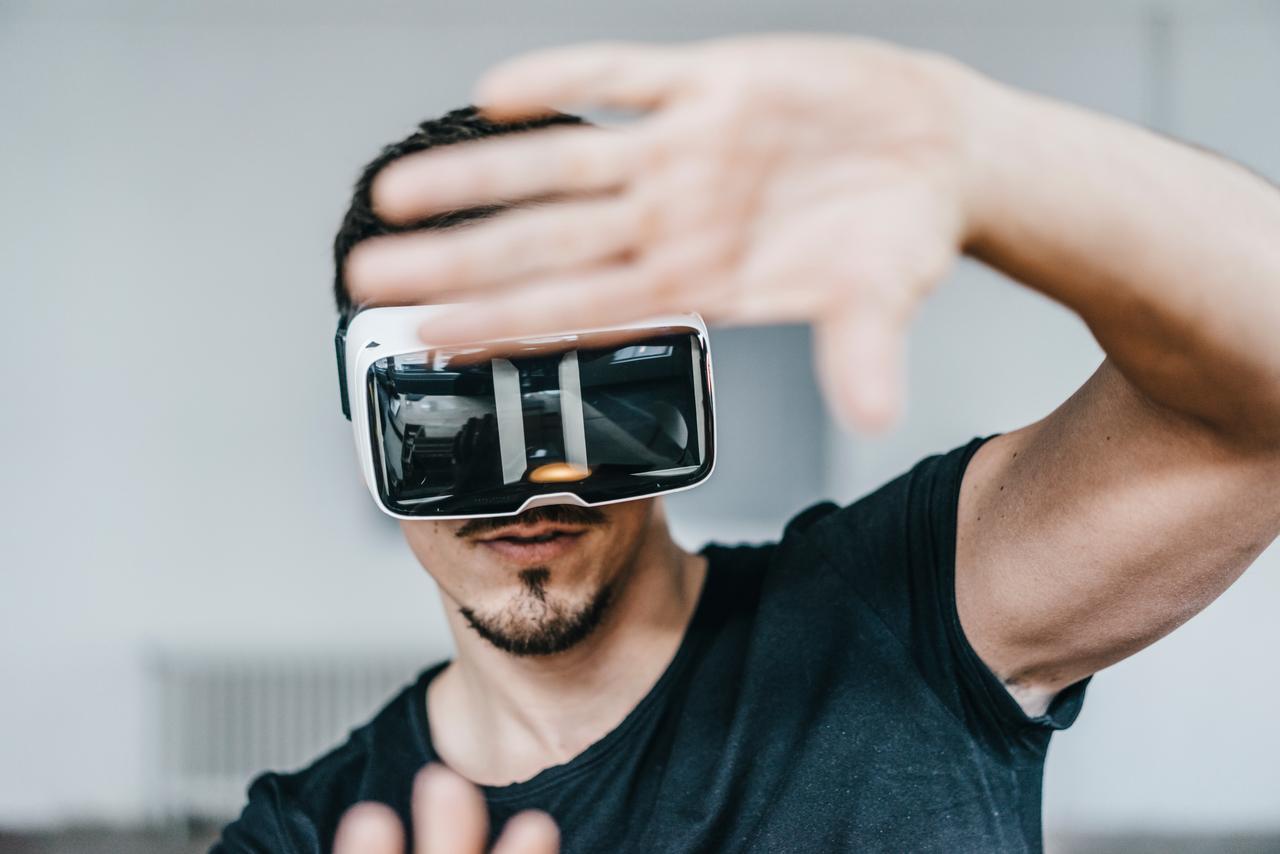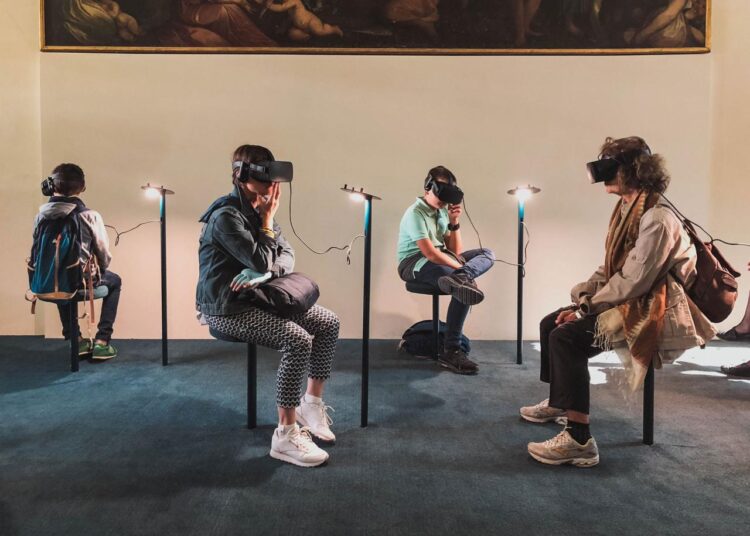Advanced VR Hardware

The leap in virtual reality experiences is intrinsically linked to the continuous innovation in VR headset design, display technology, and tracking systems, all aimed at creating a more believable and comfortable sense of presence.
A. High-Resolution Displays and Optics: At the forefront of VR’s latest chapter are high-resolution displays and advanced optics. Modern VR headsets are moving beyond basic screens to incorporate stunning 4K and even 8K displays per eye, often utilizing technologies like Micro-OLED or QLED. This drastic increase in pixel density minimizes the “screen-door effect” and significantly enhances visual fidelity, making virtual worlds appear sharper and more realistic. Alongside display improvements, advanced optics such as pancake lenses allow for thinner, lighter headset designs with wider fields of view, reducing distortion and increasing user comfort. Foveated rendering, a technique that renders only the area where the user is looking in high detail, optimizes graphical performance, ensuring smooth frame rates even with demanding visuals.
B. Inside-Out Tracking and Spatial Mapping: Early VR systems often required external cameras or sensors for tracking head and hand movements. Today, inside-out tracking has become the standard, with cameras and sensors built directly into the headset. This revolutionary approach simplifies setup, offers greater freedom of movement, and enables spatial mapping, allowing the headset to understand the physical environment, including walls, furniture, and obstacles. This capability is crucial for room-scale VR, mixed reality pass-through (blending virtual content with the real world), and creating more robust, untethered experiences that adapt to the user’s physical space.
C. Comfort and Ergonomics: For VR to be truly immersive and widely adopted, comfort and ergonomics are paramount. Manufacturers are focusing on lighter materials, better weight distribution, and adjustable headstraps to reduce fatigue during extended use. Improved facial interfaces that are breathable and prevent light leakage enhance immersion, while integrated audio solutions (often near-ear speakers or high-fidelity headphones) provide spatial audio cues that heighten the sense of presence. The goal is to make the hardware disappear, allowing the user to fully focus on the virtual world.
D. Advanced Controllers and Haptic Feedback: VR interaction extends beyond head movements to hand and body control. Advanced VR controllers offer intuitive interaction with virtual objects, featuring precise tracking, pressure sensitivity, and nuanced haptic feedback. This haptic feedback goes beyond simple vibrations, simulating textures, impacts, and even resistance, making virtual interactions feel more tangible. Beyond controllers, full-body tracking solutions, haptic vests, and even haptic shoes are emerging to provide a truly multi-sensory experience, allowing users to “feel” the virtual environment in unprecedented ways, further enhancing the sense of immersion and realism.
VR’s Transformative Applications
While entertainment remains a strong driver, VR’s latest chapter is marked by its profound impact across diverse sectors, proving its value as a powerful tool for training, collaboration, and social connection.
A. Professional Training and Simulation: Virtual reality is revolutionizing professional training and simulation across numerous high-stakes industries. Surgeons can practice complex operations in hyper-realistic virtual operating rooms, pilots can master emergency procedures in detailed flight simulators, and first responders can train for disaster scenarios without real-world risks. VR simulations offer safe, repeatable, and cost-effective training environments, allowing professionals to develop critical skills, build muscle memory, and refine decision-making in a controlled yet immersive setting, leading to improved performance and reduced real-world errors.
B. Education and Experiential Learning: In the realm of education, VR is transforming passive learning into immersive, experiential journeys. Students can virtually explore ancient civilizations, dissect human anatomy in 3D, conduct dangerous chemistry experiments safely, or even visit distant galaxies. VR field trips transcend geographical and financial barriers, making learning more engaging, memorable, and accessible. It allows for “learning by doing” in contexts that would otherwise be impossible, fostering deeper understanding and curiosity across all age groups and subjects.
C. Remote Collaboration and Virtual Workspaces: As remote work becomes more prevalent, VR is offering revolutionary solutions for remote collaboration and virtual workspaces. Platforms like Meta Horizon Workrooms, Spatial, and Engage allow teams to meet as avatars in persistent virtual environments, facilitating natural communication, shared whiteboard sessions, 3D model manipulation, and collaborative brainstorming as if they were in the same physical room. This enhances team cohesion, reduces travel costs, and provides a more engaging and productive alternative to traditional video conferencing, particularly for tasks involving visual collaboration.
D. Healthcare and Therapy: VR is increasingly being utilized in healthcare and therapy. It’s used for pain management, distracting patients during uncomfortable procedures, and providing exposure therapy for phobias (e.g., fear of heights, social anxiety) in a controlled environment. VR is also a powerful tool for physical therapy, making rehabilitation exercises more engaging and trackable. Furthermore, it aids in psychological treatment, allowing patients to safely confront traumatic memories or practice social skills in a non-threatening virtual setting, leading to tangible improvements in mental and physical well-being.
E. Retail, Real Estate, and Tourism: VR is transforming how consumers interact with products and destinations. In retail, virtual storefronts allow customers to browse and “try on” clothes in a virtual dressing room. In real estate, prospective buyers can take immersive virtual tours of properties from anywhere in the world, experiencing spaces as if they were physically present. For tourism, VR offers virtual travel experiences, allowing users to explore famous landmarks or exotic destinations before booking a trip, or providing accessible alternatives for those unable to travel physically. This creates richer, more informed purchasing decisions and expands access to experiences.
Connecting in Virtual Spaces

VR’s latest chapter is also profoundly impacting social interaction, offering new ways for people to connect, share experiences, and build communities in persistent virtual worlds.
A. Social VR Platforms and Communities: Social VR platforms like VRChat, Rec Room, and AltspaceVR (though soon to be retired for business focus) enable users to meet, interact, and create together as avatars in diverse virtual environments. These platforms host everything from casual hangouts and virtual concerts to educational events and creative workshops. The sense of “presence” in VR fosters deeper connections than traditional online interactions, allowing for more natural body language, spatial audio, and shared experiences that build strong virtual communities and friendships across geographical boundaries.
B. Virtual Events and Concerts: The pandemic significantly accelerated the trend of virtual events and concerts in VR. Artists perform for massive virtual audiences, leveraging the immersive nature of VR to create unique, interactive experiences that transcend the limitations of physical venues. Conferences, trade shows, and educational summits are also finding new life in VR, offering engaging networking opportunities, keynote speeches in stunning virtual auditoriums, and interactive exhibit halls that provide a richer experience than standard online webinars.
C. Digital Avatars and Identity Expression: In social VR, digital avatars become a crucial component of identity expression. Users can customize their avatars extensively, creating highly stylized or photorealistic representations of themselves, or exploring entirely new personas. The advancements in avatar realism and expressiveness (e.g., eye tracking, facial tracking to convey emotions) enhance the sense of connection and authenticity in virtual interactions. This freedom of identity expression fosters creativity and allows individuals to explore different facets of themselves in a safe, digital space.
D. The Metaverse as a Social Construct: The vision of the metaverse represents the ultimate convergence of immersive technologies, where persistent, interconnected virtual worlds allow users to seamlessly move between experiences, socialize, work, and engage in commerce as digital avatars. While still nascent, VR hardware and social platforms are the leading edge of this ambition, aiming to create a unified digital frontier where social interaction is as rich and varied as in the physical world, creating new paradigms for community, entertainment, and digital economies.
Software and Development Tools
The sophisticated experiences within VR’s latest chapter are built upon powerful software platforms and development tools that empower creators and ensure seamless operation.
A. Game Engines for VR Development: Game engines like Unity and Unreal Engine are the primary tools for building VR experiences. These robust platforms provide comprehensive development environments for creating 3D worlds, implementing physics, managing animations, and handling complex interactions. Their integrated rendering pipelines and optimization tools are crucial for achieving the high frame rates and low latency required for comfortable VR. The continuous updates to these engines, with dedicated VR SDKs and plugins, empower developers to push the boundaries of immersive content creation.
B. VR SDKs and Development Frameworks: Each VR headset and platform (e.g., Meta Quest, SteamVR, PlayStation VR2, Apple Vision Pro) has its own Software Development Kits (SDKs) and development frameworks. These provide APIs and tools for accessing headset features, controller inputs, tracking data, and rendering pipelines. Standards like OpenXR aim to unify these SDKs, allowing developers to build experiences that can run across multiple VR platforms without significant modification, fostering greater interoperability and reducing development complexity.
C. VR Content Creation Tools: Beyond core engines, a suite of VR content creation tools is emerging. This includes VR sculpting applications (e.g., Adobe Medium, MasterpieceVR) that allow artists to create 3D models directly within VR using intuitive gestural controls. Photogrammetry software and volumetric capture systems allow for the creation of realistic 3D models of real-world objects and environments, enhancing realism in virtual spaces. These tools democratize 3D content creation, making it more accessible to artists without traditional modeling skills.
D. Cloud VR and Streaming Solutions: To overcome the computational demands of high-fidelity VR, cloud VR and streaming solutions are gaining traction. These technologies render VR experiences on powerful remote servers and stream the content wirelessly to the headset, reducing the need for expensive local hardware. This opens up high-fidelity VR to a wider audience, enables more graphically complex experiences, and facilitates remote collaboration on large-scale VR projects without significant local processing power.
Challenges and Ethical Considerations
While immersive VR’s latest chapter promises immense progress, its widespread adoption and continued evolution face several significant challenges and ethical considerations that demand careful and proactive management.
A. Hardware Accessibility and Affordability: Despite advancements, high-end VR hardware can still be expensive, limiting broad consumer adoption. While standalone headsets are more affordable, the cost of top-tier PCs for PC VR remains a barrier. Driving down manufacturing costs and developing more accessible, feature-rich standalone devices are crucial for democratizing VR experiences and ensuring equitable access.
B. Motion Sickness and User Comfort: For some users, VR can induce motion sickness (cybersickness) due to the mismatch between visual input and physical movement. While display improvements, higher refresh rates, and better tracking mitigate this, it remains a challenge. Continuous research into physiological responses to VR, alongside optimized content design and personalized comfort settings, is vital for improving the user experience and reducing discomfort for all.
C. Data Privacy, Security, and Identity in Virtual Worlds: As users spend more time in VR, concerns about data privacy, security, and identity in virtual worlds intensify. VR platforms collect vast amounts of biometric data (eye tracking, body movement) and social interaction data. Ensuring robust data protection, transparent data usage policies, and establishing clear guidelines for digital identity, ownership of virtual assets, and social interactions within virtual spaces are critical for building trust and protecting users.
D. Ethical Considerations and Responsible VR Design: The immersive nature of VR raises unique ethical questions. This includes concerns about the psychological impact of highly realistic or violent content, potential for addiction, the spread of misinformation in virtual spaces, and the nature of consent in virtual interactions. Developing responsible VR design principles, implementing content moderation, and fostering digital literacy are crucial to ensure VR is a positive and empowering technology.
E. Interoperability and the Open Metaverse: The current VR landscape is somewhat fragmented, with different platforms and ecosystems. Achieving true interoperability and building an open metaverse where users can seamlessly move avatars and digital assets between different virtual worlds is a significant technical and business challenge. Industry collaboration and the adoption of open standards (like OpenXR, WebXR) are essential to create a cohesive and user-friendly virtual ecosystem, preventing walled gardens and fostering innovation.
F. Long-Term Societal Impact: As VR becomes more integrated into daily life, its long-term societal impact needs careful consideration. How might it change human connection? What are the implications for work, education, and entertainment? Proactive research and societal dialogue are needed to anticipate and navigate these profound shifts, ensuring VR’s development aligns with human well-being and societal progress.
Conclusion
Immersive VR’s latest chapter represents a monumental leap in human-computer interaction, pushing the boundaries of presence and redefining our relationship with digital content and each other. Beyond its entertainment roots, VR is now a powerful, transformative tool revolutionizing professional training, education, healthcare, and social connection. While challenges related to accessibility, comfort, and ethical governance remain, the boundless potential for VR to unlock new forms of learning, collaboration, and empathy is undeniable. As hardware becomes more refined and content more compelling, virtual reality is poised to become an indispensable part of our lives, creating new dimensions of experience and truly blending the digital with the physical world.







